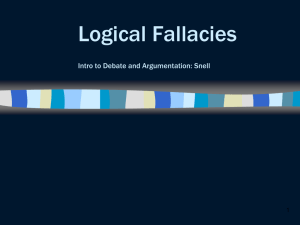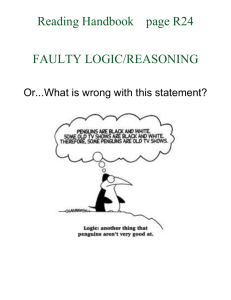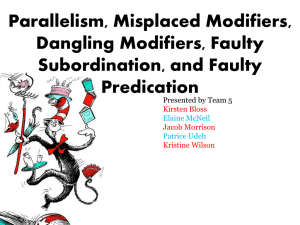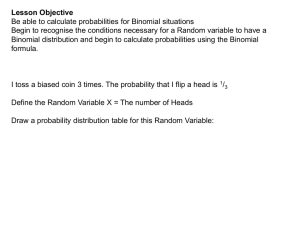Methods S1
advertisement
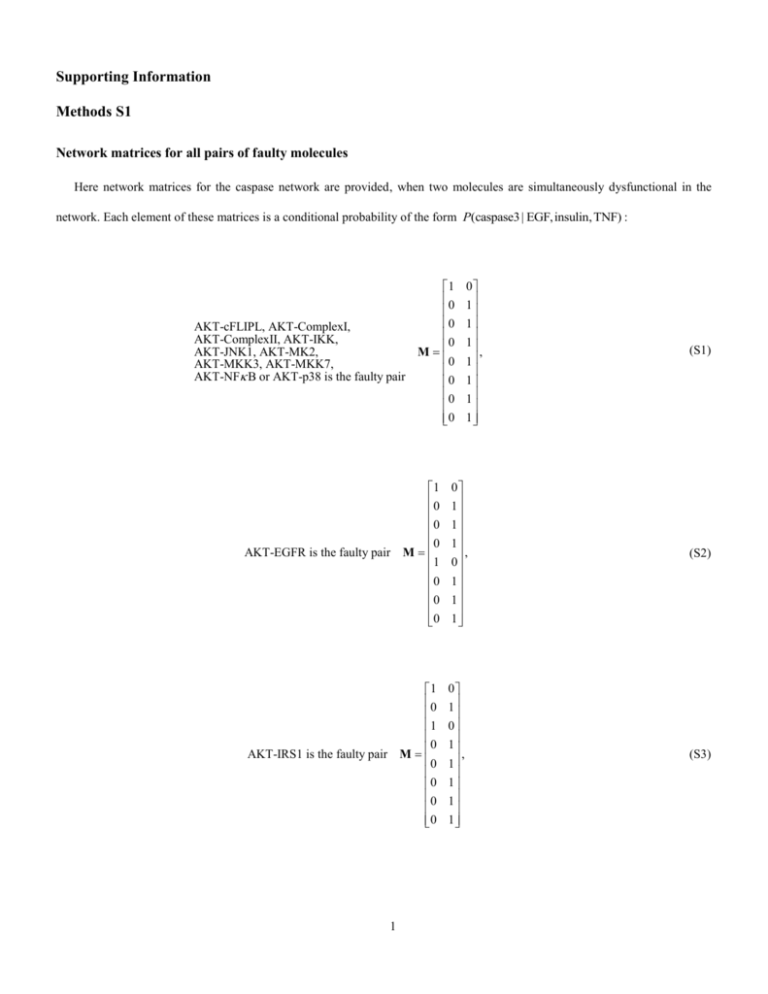
Supporting Information Methods S1 Network matrices for all pairs of faulty molecules Here network matrices for the caspase network are provided, when two molecules are simultaneously dysfunctional in the network. Each element of these matrices is a conditional probability of the form P(caspase3 | EGF,insulin, TNF) : 1 0 0 AKT-cFLIPL, AKT-ComplexI, AKT-ComplexII, AKT-IKK, 0 AKT-JNK1, AKT-MK2, M 0 AKT-MKK3, AKT-MKK7, AKT-NF B or AKT-p38 is the faulty pair 0 0 0 0 1 1 1 , 1 1 1 1 (S1) 1 0 0 0 AKT-EGFR is the faulty pair M 1 0 0 0 0 1 1 1 , 0 1 1 1 (S2) 1 0 1 0 AKT-IRS1 is the faulty pair M 0 0 0 0 0 1 0 1 , 1 1 1 1 (S3) 1 1 1 0 1 AKT-MEKK1ASK1 is the faulty pair M 0 1 0 1 1 0 1 0 AKT-caspase8, AKT-ERK, M or AKT-MEK is the faulty pair 1 0 1 0 caspase8-ComplexI, caspase8-MEKK1ASK1, ComplexI-ComplexII, ComplexII-MEKK1ASK1, EGFR-MEKK1ASK1, ERK-MEKK1ASK1, IRS1-MEKK1ASK1, JNK1-MEKK1ASK1, JNK1-MK2, JNK1-MKK3, JNK1-p38, MEK-MEKK1ASK1, MEKK1ASK1-MK2, MEKK1ASK1-MKK3, MEKK1ASK1-MKK7, MEKK1ASK1-p38, MK2-MKK7, MKK3-MKK7 or MKK7-p38 is the faulty pair 0 0 1 0 , 1 0 1 0 (S4) 0 1 0 1 , 0 1 0 1 (S5) 1 1 1 1 M 1 1 1 1 1 0 1 caspase8-EGFR, cFLIPL-EGFR, ComplexI-EGFR, ComplexII-EGFR, EGFR-ERK, EGFR-IKK, EGFR-IRS1 1 M EGFR-JNK1, EGFR-MEK, EGFR-MK2, EGFR-MKK3, 1 EGFR-MKK7, EGFR-NF B or EGFR-p38 is the faulty pair 0 1 1 2 0 0 0 0 , 0 0 0 0 0 1 0 0 , 0 1 0 0 (S6) (S7) 1 0 1 1 Each of the rest of the pairs is faulty M 1 1 1 1 3 0 1 0 0 , 0 0 0 0 (S8) Network matrices for the ternary model Here network matrices for ternary model of the caspase network are provided. Equation (S9) is for the case when there is no faulty molecule in the network, whereas (S10) - (S15) represent the network when there is a faulty molecule. Each element of these matrices is a conditional probability of the form P(caspase3 | EGF,insulin, TNF) . For any given input pattern, this specifies the probability of the output to be 0, 1/2 or 1. P (0 | 000) 1 P (0 | 00 2 ) P (0 | 001) 1 P (0 | 0 2 0) P (0 | 0 1 1 ) 2 2 1 P (0 | 0 2 1) P (0 | 010) P (0 | 01 12 ) P (0 | 011) P (0 | 12 00) 1 1 P (0 | 2 0 2 ) P (0 | 1 01) 2 P (0 | 12 12 0) M P (0 | 12 12 12 ) P (0 | 12 12 1) 1 P (0 | 2 10) P (0 | 1 1 1 ) 2 2 1 P (0 | 2 11) P (0 | 100) P (0 | 10 12 ) P (0 | 101) P (0 | 1 12 0) 1 1 P (0 | 1 2 2 ) P (0 | 1 1 1) 2 P (0 | 110) P (0 | 11 1 ) 2 P (0 | 111) P ( 12 | 000) P ( 12 | 00 12 ) P ( 12 | 001) P ( 12 | 0 12 0) P ( 12 | 0 12 12 ) P ( 12 | 0 12 1) P ( 12 | 010) P ( 12 | 01 12 ) P ( 12 | 011) P ( 12 | 12 00) P ( 12 | 12 0 12 ) P ( 12 | 12 01) P ( 12 | 12 12 0) P ( 12 | 12 12 12 ) P ( 12 | 12 12 1) P ( 12 | 12 10) P ( 12 | 12 1 12 ) P ( 12 | 12 11) P ( 12 | 100) P ( 12 | 10 12 ) P ( 12 | 101) P ( 12 | 1 12 0) P ( 12 | 1 12 12 ) P ( 12 | 1 12 1) P ( 12 | 110) P ( 12 | 11 12 ) P ( 12 | 111) P (1 | 000) 1 P (1 | 00 12 ) 0 P (1 | 001) 0 P (1 | 0 12 0) 0 P (1 | 0 12 12 ) 0 P (1 | 0 12 1) 0 P (1 | 010) 1 P (1 | 01 12 ) 1 P (1 | 011) 1 P (1 | 12 00) 0 P (1 | 12 0 12 ) 0 P (1 | 12 01) 0 P (1 | 12 12 0) 0 P (1 | 12 12 12 ) 0 P (1| 12 12 1) 0 P (1| 12 10) 1 P (1| 12 1 12 ) 1 P (1| 12 11) 1 P (1| 100) 1 P (1| 10 12 ) 1 P (1| 101) 1 P (1| 1 12 0) 1 P (1| 1 12 12 ) 1 P (1| 1 12 1) 1 P (1| 110) 1 P (1| 11 12 ) 1 P (1| 111) 1 caspase3 = 0 4 0 1 0 1 1 1 0 0 0 1 1 1 1 1 1 0 0 0 0 0 0 0 0 0 0 0 0 1 2 0 0 1 0 0 0 0 0 0 0 0 0 0 0 0 0 0 0 0 0 0 0 0 . 0 0 0 0 1 (S9) Equation (S10) is the network matrix M for the ternary model, when the faulty molecule is AKT. 1 1 1 AKT is faulty M with probability p 1 1 1 1 1 1 1 1 1 1 1 1 1 0 0 0 1 0 0 1 0 1 0 1 p p p 0 p p 0 0 0 1 1 0 1 p 0 1 0 1 0 1 p p 0 p p p 0 p p 0 p p 0 p p 0 p p p 0 0 p p p 0 5 0 0 1 0 0 p p 0 p 0 0 p 0 0 p p 0 p p 0 p p . 0 p p 0 p (S10) Equation (S11) is the network matrix M for the ternary model, when the faulty molecule is EGFR. EGFR is faulty M with probability p 1 1 1 1 1 1 0 0 0 1 0 0 1 0 0 1 1 1 1 0 0 1 0 p 1 p 0 1 0 1 p 0 1 0 0 1 1 1 0 1 1 0 0 1 p 0 p p 0 p p p p p 1 p 0 1 1 0 0 6 0 0 1 0 0 0 0 0 0 0 0 p 0 0 0 0 0 0 0 0 p 0 0 0 0 0 0 (S11) Equation (S12) is the network matrix M for the ternary model, when the faulty molecule is MEKK1ASK1. 0 1 0 1 p 0 1 1 0 0 1 p 1 p 1 0 0 1 1 0 0 1 1 0 p 1 p MEKK1ASK1 1 0 is faulty with M 0 1 p 1 p probability p 0 1 1 0 0 1 1 0 0 1 1 0 1 0 0 1 1 0 1 0 1 0 0 1 7 0 0 p 0 0 0 0 0 0 0 0 0 0 0 0 0 0 0 0 0 0 0 0 0 0 0 0 (S12) Equation (S13) is the network matrix M for the ternary model, when the faulty molecule is caspase8, ERK or MEK. 0 0 1 0 1 0 0 0 1 p 1 p 0 0 1 0 1 0 0 1 0 0 0 0 1 0 0 1 p 1 p 0 1 0 0 0 1 0 Caspase8, ERK or MEK p 1 p 0 is faulty with M 0 1 0 0 probability p 1 0 0 0 1 1 0 0 0 0 1 1 0 0 0 0 1 1 0 0 1 0 0 0 0 1 1 0 0 0 0 1 1 0 0 0 0 1 8 (S13) Equation (S14) is the network matrix M for the ternary model, when the faulty molecule is IRS1. 1 0 0 p 1 0 0 1 1 1 0 0 0 IRS1 0 is faulty with M 0 0 probability p 1 1 1 1 1 1 1 1 1 1 1 1 9 0 0 1 0 0 1 p 0 1 0 1 0 0 0 0 0 0 0 1 0 1 0 1 0 1 0 1 0 1 0 0 0 0 0 0 0 0 0 0 0 0 0 0 0 0 0 0 0 0 0 0 0 0 0 (S14) Equation (S15) is the network matrix M for the ternary model, when the faulty molecule is IKK, ComplexI, ComplexII, NFκB, JNK1, MK2, cFLIPL, MKK3, MKK7 or p38. IKK, ComplexI, ComplexII, NF B, JNK1, MK2, cFLIPL, MKK3, MKK7, or p38 is faulty with probability p 1 0 0 0 0 0 1 1 1 0 0 0 0 M 0 0 1 1 1 1 1 1 1 1 1 1 1 1 10 0 0 1 0 0 1 1 0 1 0 1 0 0 0 0 0 0 0 1 0 1 0 1 0 1 0 1 0 1 0 0 0 0 0 0 0 0 0 0 0 0 0 0 0 0 0 0 0 0 0 0 0 0 0 (S15) Equations for vulnerabilities in terms of the input activities The vulnerability formula in (7) is for the case when inputs are equi-probable. When inputs have different activity levels, we can compute the vulnerability of a network to the dysfunction of each individual molecule, by including input activities q1 , q2 and q3 in (6), as follows: V P(0 | 001)(1 q1 )(1 q2 )q3 P (1| 000)(1 q1 )(1 q2 )(1 q3 ) P (1| 010)(1 q1 )q2 (1 q3 ) P(1| 011)(1 q1 ) q2 q3 P(1| 100)q1 (1 q2 )(1 q3 ) P (1| 101)q1 (1 q2 )q3 P (1| 110)q1q2 (1 q3 ) P (1| 111)q1q2 q3. (S16) By replacing the above conditional probabilities with the elements of the matrices in (2)-(5), the following equations can be obtained for the vulnerability of each molecule in terms of its fault probability p and the input activities q1 , q2 and q3 : AKT is faulty, p (q1 q 2 q1q 2 ), pq (1 q )q , EGFR is faulty, 1 2 3 V p (1 q )(1 q ) q , MEKK1 ASK1 is faulty, 1 2 3 0, otherwise. For q1 q2 q3 1 / 2 , (S17) reduces to (8). 11 (S17)

